2007 CHEVROLET CORVETTE maintenance
[x] Cancel search: maintenancePage 212 of 488
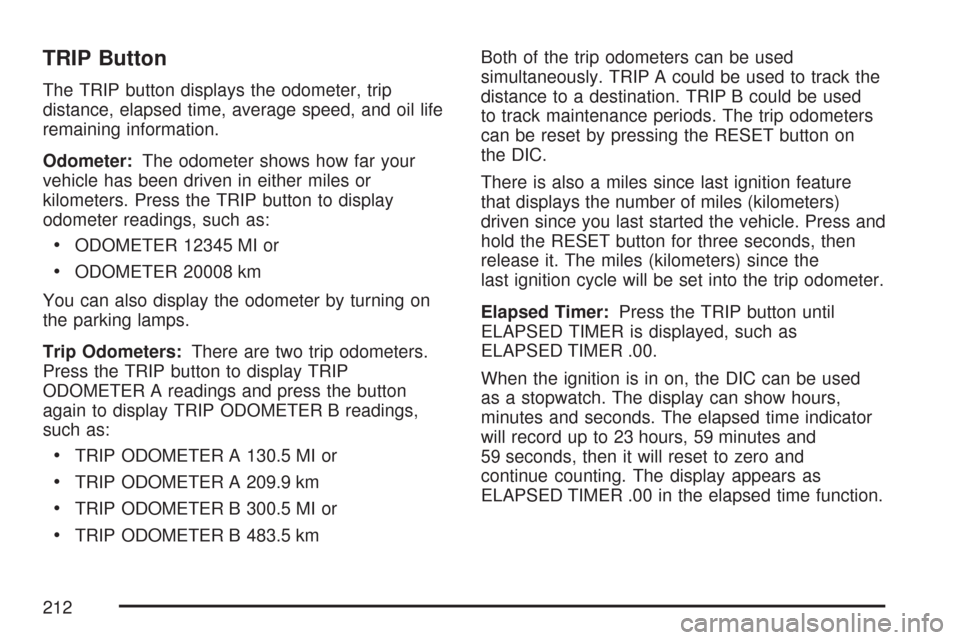
TRIP Button
The TRIP button displays the odometer, trip
distance, elapsed time, average speed, and oil life
remaining information.
Odometer:The odometer shows how far your
vehicle has been driven in either miles or
kilometers. Press the TRIP button to display
odometer readings, such as:
ODOMETER 12345 MI or
ODOMETER 20008 km
You can also display the odometer by turning on
the parking lamps.
Trip Odometers:There are two trip odometers.
Press the TRIP button to display TRIP
ODOMETER A readings and press the button
again to display TRIP ODOMETER B readings,
such as:
TRIP ODOMETER A 130.5 MI or
TRIP ODOMETER A 209.9 km
TRIP ODOMETER B 300.5 MI or
TRIP ODOMETER B 483.5 kmBoth of the trip odometers can be used
simultaneously. TRIP A could be used to track the
distance to a destination. TRIP B could be used
to track maintenance periods. The trip odometers
can be reset by pressing the RESET button on
the DIC.
There is also a miles since last ignition feature
that displays the number of miles (kilometers)
driven since you last started the vehicle. Press and
hold the RESET button for three seconds, then
release it. The miles (kilometers) since the
last ignition cycle will be set into the trip odometer.
Elapsed Timer:Press the TRIP button until
ELAPSED TIMER is displayed, such as
ELAPSED TIMER .00.
When the ignition is in on, the DIC can be used
as a stopwatch. The display can show hours,
minutes and seconds. The elapsed time indicator
will record up to 23 hours, 59 minutes and
59 seconds, then it will reset to zero and
continue counting. The display appears as
ELAPSED TIMER .00 in the elapsed time function.
212
Page 213 of 488

You can start or stop the elapsed time by pressing
the RESET button. To reset the elapsed time to
zero, press the RESET button for three seconds
while the timer is displayed.
Pressing and holding the RESET button for at
least 10 seconds will reset the timer display to the
time since last ignition cycle.
Average Speed:Press the TRIP button until the
average speed is displayed, such as:
AVERAGE SPEED 62 MPH or
AVERAGE SPEED 100 km/h
Press and hold the RESET button to reset to
0.0 mph (km/h).
Engine Oil Life:Press the TRIP button until the
engine oil life is displayed, such as OIL LIFE
REMAINING 89%.
This is an estimate of the engine oil’s remaining
useful life. It will show 100% when the system
is reset after an oil change. It will alert you
to change your oil on a schedule consistent with
your driving conditions.When the remaining oil life is low, the system will
alert you with the message CHANGE ENGINE OIL.
Remember, you must reset the engine oil life
system yourself after each oil change. It will not
reset itself. To reset the system, seeEngine
Oil Life System on page 340. Be careful not to
reset the engine oil life system accidentally at any
time other than when the oil has just been
changed. It cannot be reset accurately until the
next oil change.
SeeScheduled Maintenance on page 433and
Engine Oil on page 333for more information.
OPTION Button
The OPTION button allows you to access the
PERSONAL OPTIONS menu and customize the
personalization settings on your vehicle. See
DIC Vehicle Personalization on page 234for more
information.
RESET Button
The RESET button, used along with other buttons,
will reset system functions and turn off or
acknowledge messages on the DIC.
213
Page 217 of 488
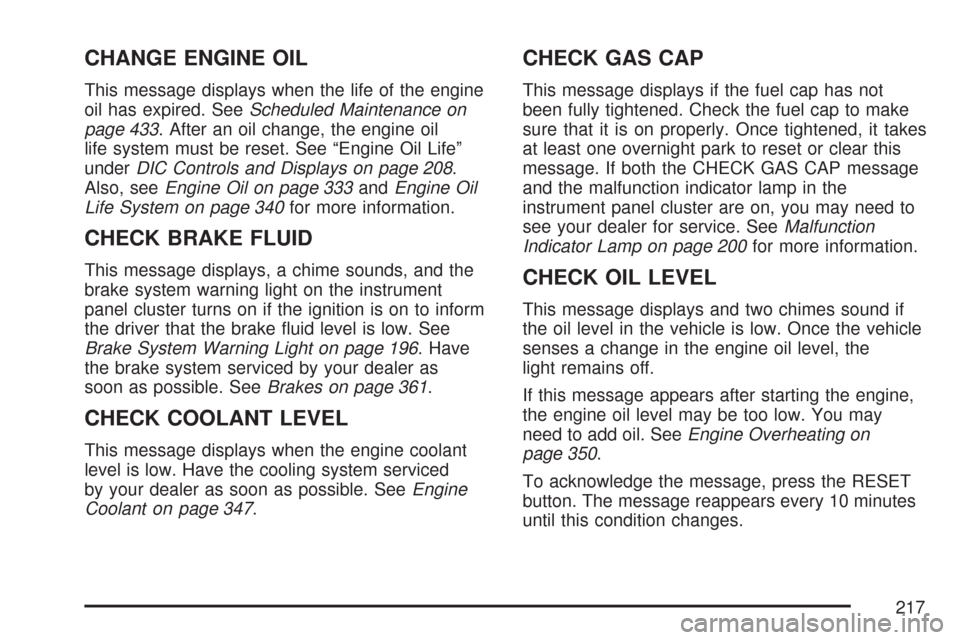
CHANGE ENGINE OIL
This message displays when the life of the engine
oil has expired. SeeScheduled Maintenance on
page 433. After an oil change, the engine oil
life system must be reset. See “Engine Oil Life”
underDIC Controls and Displays on page 208.
Also, seeEngine Oil on page 333andEngine Oil
Life System on page 340for more information.
CHECK BRAKE FLUID
This message displays, a chime sounds, and the
brake system warning light on the instrument
panel cluster turns on if the ignition is on to inform
the driver that the brake �uid level is low. See
Brake System Warning Light on page 196. Have
the brake system serviced by your dealer as
soon as possible. SeeBrakes on page 361.
CHECK COOLANT LEVEL
This message displays when the engine coolant
level is low. Have the cooling system serviced
by your dealer as soon as possible. SeeEngine
Coolant on page 347.
CHECK GAS CAP
This message displays if the fuel cap has not
been fully tightened. Check the fuel cap to make
sure that it is on properly. Once tightened, it takes
at least one overnight park to reset or clear this
message. If both the CHECK GAS CAP message
and the malfunction indicator lamp in the
instrument panel cluster are on, you may need to
see your dealer for service. SeeMalfunction
Indicator Lamp on page 200for more information.
CHECK OIL LEVEL
This message displays and two chimes sound if
the oil level in the vehicle is low. Once the vehicle
senses a change in the engine oil level, the
light remains off.
If this message appears after starting the engine,
the engine oil level may be too low. You may
need to add oil. SeeEngine Overheating on
page 350.
To acknowledge the message, press the RESET
button. The message reappears every 10 minutes
until this condition changes.
217
Page 272 of 488
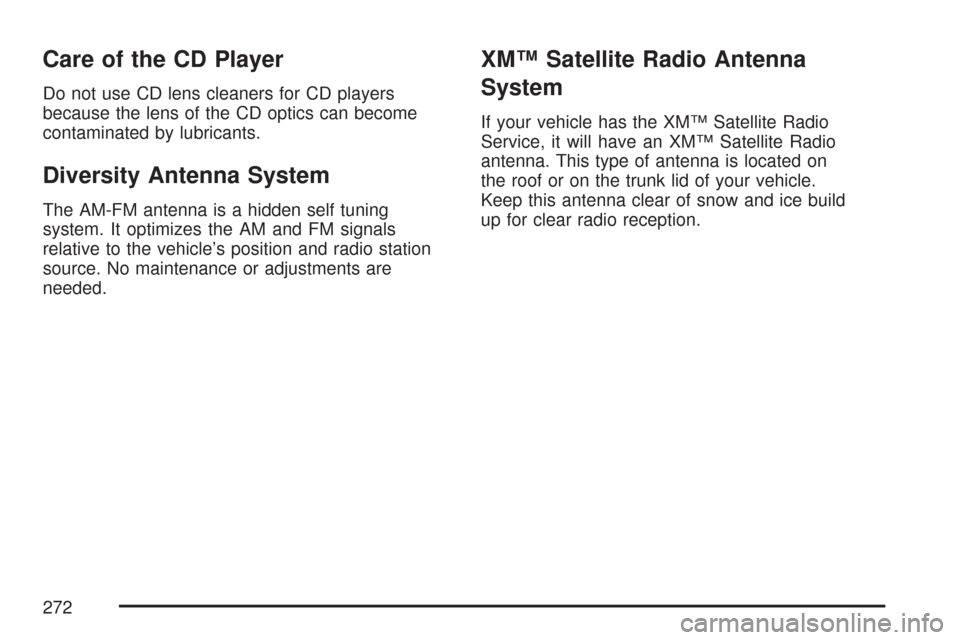
Care of the CD Player
Do not use CD lens cleaners for CD players
because the lens of the CD optics can become
contaminated by lubricants.
Diversity Antenna System
The AM-FM antenna is a hidden self tuning
system. It optimizes the AM and FM signals
relative to the vehicle’s position and radio station
source. No maintenance or adjustments are
needed.
XM™ Satellite Radio Antenna
System
If your vehicle has the XM™ Satellite Radio
Service, it will have an XM™ Satellite Radio
antenna. This type of antenna is located on
the roof or on the trunk lid of your vehicle.
Keep this antenna clear of snow and ice build
up for clear radio reception.
272
Page 293 of 488
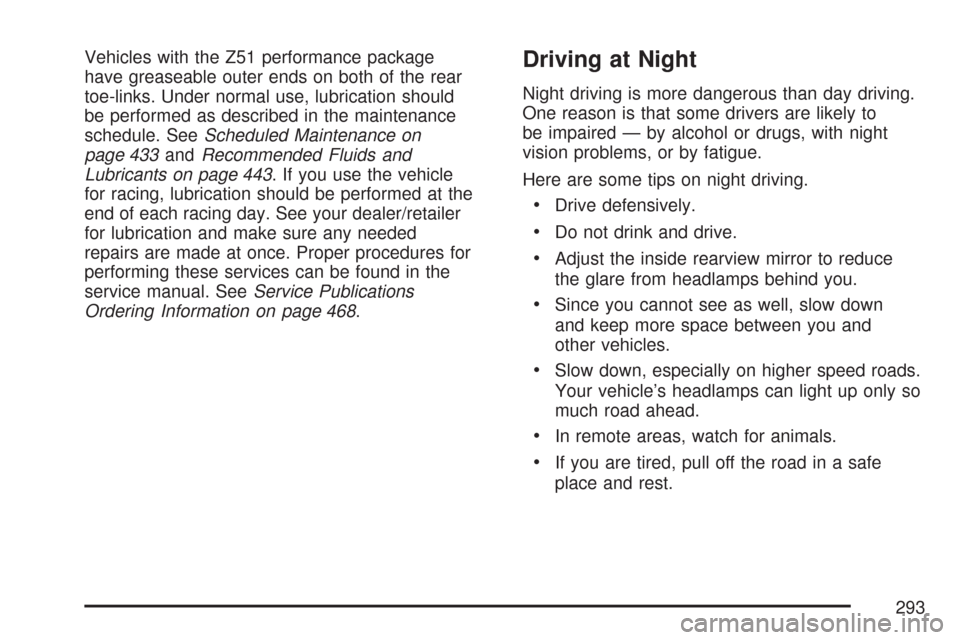
Vehicles with the Z51 performance package
have greaseable outer ends on both of the rear
toe-links. Under normal use, lubrication should
be performed as described in the maintenance
schedule. SeeScheduled Maintenance on
page 433andRecommended Fluids and
Lubricants on page 443. If you use the vehicle
for racing, lubrication should be performed at the
end of each racing day. See your dealer/retailer
for lubrication and make sure any needed
repairs are made at once. Proper procedures for
performing these services can be found in the
service manual. SeeService Publications
Ordering Information on page 468.Driving at Night
Night driving is more dangerous than day driving.
One reason is that some drivers are likely to
be impaired — by alcohol or drugs, with night
vision problems, or by fatigue.
Here are some tips on night driving.
Drive defensively.
Do not drink and drive.
Adjust the inside rearview mirror to reduce
the glare from headlamps behind you.
Since you cannot see as well, slow down
and keep more space between you and
other vehicles.
Slow down, especially on higher speed roads.
Your vehicle’s headlamps can light up only so
much road ahead.
In remote areas, watch for animals.
If you are tired, pull off the road in a safe
place and rest.
293
Page 318 of 488
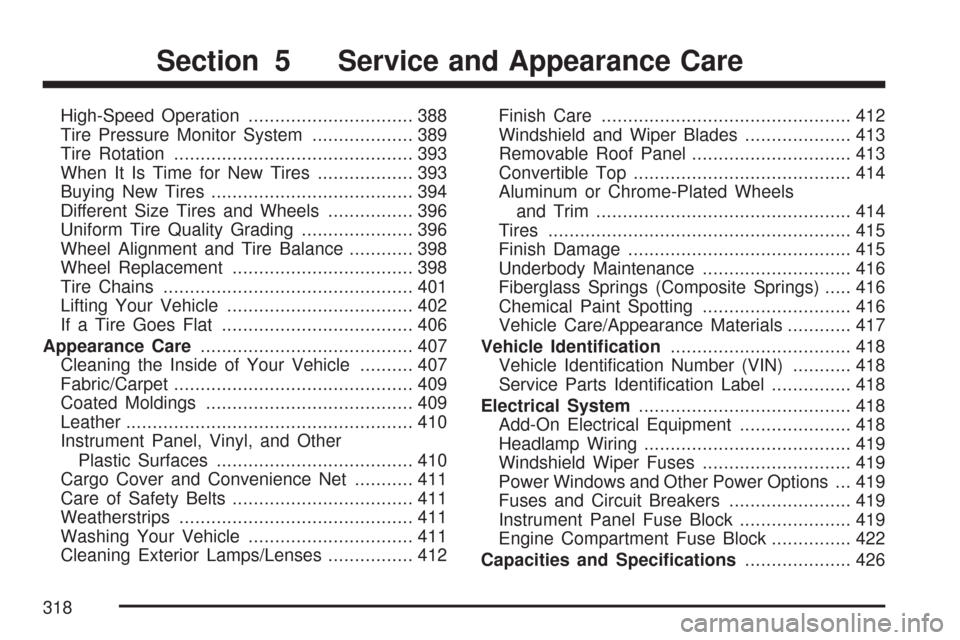
High-Speed Operation............................... 388
Tire Pressure Monitor System................... 389
Tire Rotation............................................. 393
When It Is Time for New Tires.................. 393
Buying New Tires...................................... 394
Different Size Tires and Wheels................ 396
Uniform Tire Quality Grading..................... 396
Wheel Alignment and Tire Balance............ 398
Wheel Replacement.................................. 398
Tire Chains............................................... 401
Lifting Your Vehicle................................... 402
If a Tire Goes Flat.................................... 406
Appearance Care........................................ 407
Cleaning the Inside of Your Vehicle.......... 407
Fabric/Carpet............................................. 409
Coated Moldings....................................... 409
Leather...................................................... 410
Instrument Panel, Vinyl, and Other
Plastic Surfaces..................................... 410
Cargo Cover and Convenience Net........... 411
Care of Safety Belts.................................. 411
Weatherstrips............................................ 411
Washing Your Vehicle............................... 411
Cleaning Exterior Lamps/Lenses................ 412Finish Care............................................... 412
Windshield and Wiper Blades.................... 413
Removable Roof Panel.............................. 413
Convertible Top......................................... 414
Aluminum or Chrome-Plated Wheels
and Trim................................................ 414
Tires......................................................... 415
Finish Damage.......................................... 415
Underbody Maintenance............................ 416
Fiberglass Springs (Composite Springs)..... 416
Chemical Paint Spotting............................ 416
Vehicle Care/Appearance Materials............ 417
Vehicle Identi�cation.................................. 418
Vehicle Identi�cation Number (VIN)........... 418
Service Parts Identi�cation Label............... 418
Electrical System........................................ 418
Add-On Electrical Equipment..................... 418
Headlamp Wiring....................................... 419
Windshield Wiper Fuses............................ 419
Power Windows and Other Power Options ... 419
Fuses and Circuit Breakers....................... 419
Instrument Panel Fuse Block..................... 419
Engine Compartment Fuse Block............... 422
Capacities and Speci�cations.................... 426
Section 5 Service and Appearance Care
318
Page 320 of 488
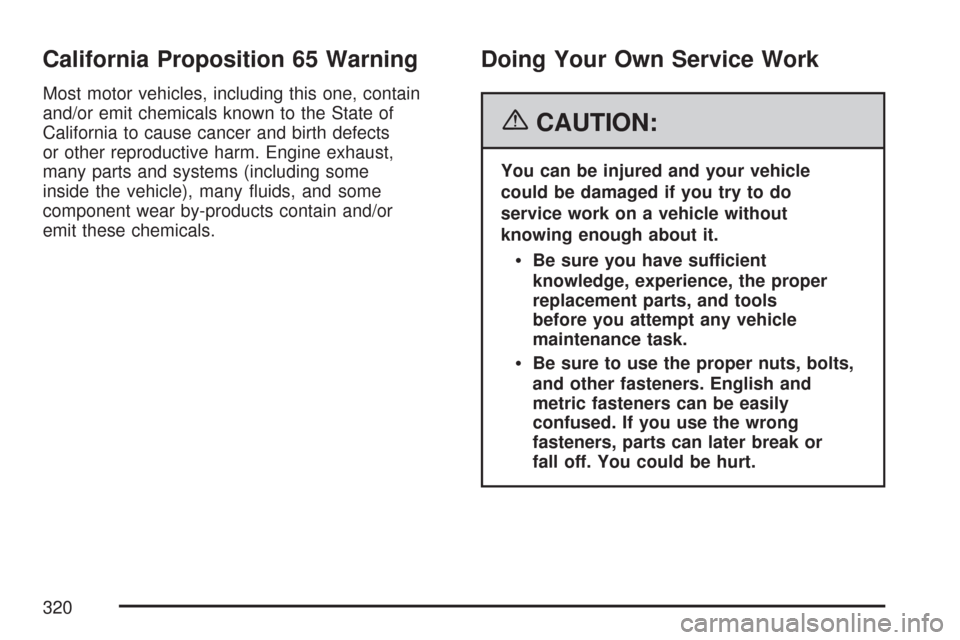
California Proposition 65 Warning
Most motor vehicles, including this one, contain
and/or emit chemicals known to the State of
California to cause cancer and birth defects
or other reproductive harm. Engine exhaust,
many parts and systems (including some
inside the vehicle), many �uids, and some
component wear by-products contain and/or
emit these chemicals.
Doing Your Own Service Work
{CAUTION:
You can be injured and your vehicle
could be damaged if you try to do
service work on a vehicle without
knowing enough about it.
Be sure you have sufficient
knowledge, experience, the proper
replacement parts, and tools
before you attempt any vehicle
maintenance task.
Be sure to use the proper nuts, bolts,
and other fasteners. English and
metric fasteners can be easily
confused. If you use the wrong
fasteners, parts can later break or
fall off. You could be hurt.
320
Page 321 of 488
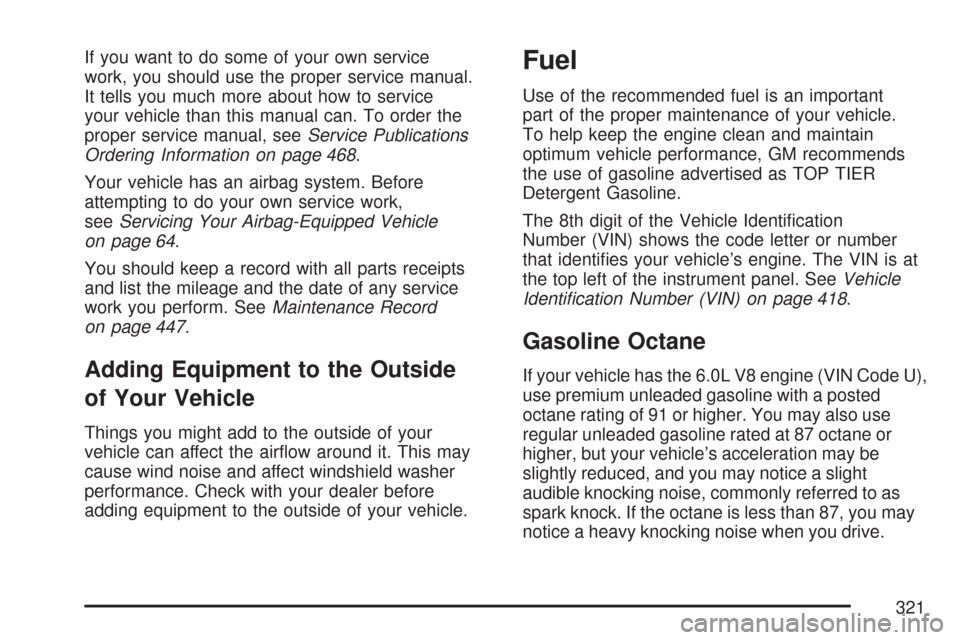
If you want to do some of your own service
work, you should use the proper service manual.
It tells you much more about how to service
your vehicle than this manual can. To order the
proper service manual, seeService Publications
Ordering Information on page 468.
Your vehicle has an airbag system. Before
attempting to do your own service work,
seeServicing Your Airbag-Equipped Vehicle
on page 64.
You should keep a record with all parts receipts
and list the mileage and the date of any service
work you perform. SeeMaintenance Record
on page 447.
Adding Equipment to the Outside
of Your Vehicle
Things you might add to the outside of your
vehicle can affect the air�ow around it. This may
cause wind noise and affect windshield washer
performance. Check with your dealer before
adding equipment to the outside of your vehicle.
Fuel
Use of the recommended fuel is an important
part of the proper maintenance of your vehicle.
To help keep the engine clean and maintain
optimum vehicle performance, GM recommends
the use of gasoline advertised as TOP TIER
Detergent Gasoline.
The 8th digit of the Vehicle Identi�cation
Number (VIN) shows the code letter or number
that identi�es your vehicle’s engine. The VIN is at
the top left of the instrument panel. SeeVehicle
Identi�cation Number (VIN) on page 418.
Gasoline Octane
If your vehicle has the 6.0L V8 engine (VIN Code U),
use premium unleaded gasoline with a posted
octane rating of 91 or higher. You may also use
regular unleaded gasoline rated at 87 octane or
higher, but your vehicle’s acceleration may be
slightly reduced, and you may notice a slight
audible knocking noise, commonly referred to as
spark knock. If the octane is less than 87, you may
notice a heavy knocking noise when you drive.
321